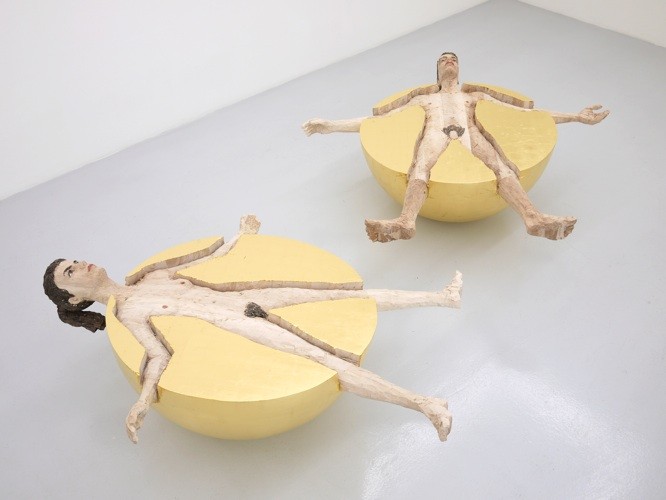Stephan Balkenhol
26 Apr - 01 Jun 2013
STEPHAN BALKENHOL
26 April - 1 June 2013
Stephan Balkenhol (born in Fritzlar, Germany, in 1957) is the premier spirit behind the revival of figurative sculpture in the early 1980s. His oeuvre stands for artists of his generation – for instance Cindy Sherman, Thomas Schütte und Katharina Fritsch – who rejected abstract, conceptual and late minimalist art as represented by such artists as Balkenhol’s teacher Ulrich Rückriem.
Balkenhol’s work ranges from full-size sculptures, installations and reliefs to photographs and drawings. He is undoubtedly one of the most important sculptors of his time. Since 1992 he has been a professor at the State Academy of the Arts in Karlsruhe, and divides his time between Germany and Meisenthal, France. Stephan Balkenhol has been represented by Mai 36 Galerie since 1989 and his work is in major museums, collections and exhibitions all over the world.
Balkenhol’s preferred material, wood, gives him the resistance he seeks. Clay is too fast for him and stone takes too long. The human image is the crux of this oeuvre, accompanied by animals, hybrid creatures and architecture. The powerful presence that informs all of this artist’s sculptures goes hand-in-hand with their curiously neutral expression.
Balkenhol wants to render the human image detached from function, from roles and, in fact, from connotation in general. He culls images from a world that interests him as sculpture; he is less interested in the world as such. There is a degree of abstraction in his sculptures that reinforces the vibrancy of his subject matter and courts ambiguity. The craftsmanship is blatant; the making of the works, inscribed in the crude surfaces, culminates in their polychromatic painting. These factors ensure the autonomy of his sculptures; they are not weighed down with content but they do leave room for it, opening avenues to background stories and potential interpretations. Balkenhol himself says that it is not his aim to compare sculpture with reality but rather to embrace the new reality that is conjured by his work.
No matter where they are placed, his works command centre stage. Moreover, their presence draws attention to place, makes it visible; they concentrate on place while at the same time eschewing any feelings of pathos. The autonomy of Balkenhol’s art means that viewers are autonomous too. The sculptures, all created especially for the exhibition, and the drawings on view are not governed by the dictates of illustration; in taking themselves seriously, they take viewers seriously as well. Viewers are challenged to rise to the occasion. Stephan Balkenhol’s works ultimately address existential issues, his works foster reflection through the concrete experience of them within the space that they occupy. It is this approach that makes Balkenhol’s work, from the early 1980s to the present day, so persuasive and compelling.
26 April - 1 June 2013
Stephan Balkenhol (born in Fritzlar, Germany, in 1957) is the premier spirit behind the revival of figurative sculpture in the early 1980s. His oeuvre stands for artists of his generation – for instance Cindy Sherman, Thomas Schütte und Katharina Fritsch – who rejected abstract, conceptual and late minimalist art as represented by such artists as Balkenhol’s teacher Ulrich Rückriem.
Balkenhol’s work ranges from full-size sculptures, installations and reliefs to photographs and drawings. He is undoubtedly one of the most important sculptors of his time. Since 1992 he has been a professor at the State Academy of the Arts in Karlsruhe, and divides his time between Germany and Meisenthal, France. Stephan Balkenhol has been represented by Mai 36 Galerie since 1989 and his work is in major museums, collections and exhibitions all over the world.
Balkenhol’s preferred material, wood, gives him the resistance he seeks. Clay is too fast for him and stone takes too long. The human image is the crux of this oeuvre, accompanied by animals, hybrid creatures and architecture. The powerful presence that informs all of this artist’s sculptures goes hand-in-hand with their curiously neutral expression.
Balkenhol wants to render the human image detached from function, from roles and, in fact, from connotation in general. He culls images from a world that interests him as sculpture; he is less interested in the world as such. There is a degree of abstraction in his sculptures that reinforces the vibrancy of his subject matter and courts ambiguity. The craftsmanship is blatant; the making of the works, inscribed in the crude surfaces, culminates in their polychromatic painting. These factors ensure the autonomy of his sculptures; they are not weighed down with content but they do leave room for it, opening avenues to background stories and potential interpretations. Balkenhol himself says that it is not his aim to compare sculpture with reality but rather to embrace the new reality that is conjured by his work.
No matter where they are placed, his works command centre stage. Moreover, their presence draws attention to place, makes it visible; they concentrate on place while at the same time eschewing any feelings of pathos. The autonomy of Balkenhol’s art means that viewers are autonomous too. The sculptures, all created especially for the exhibition, and the drawings on view are not governed by the dictates of illustration; in taking themselves seriously, they take viewers seriously as well. Viewers are challenged to rise to the occasion. Stephan Balkenhol’s works ultimately address existential issues, his works foster reflection through the concrete experience of them within the space that they occupy. It is this approach that makes Balkenhol’s work, from the early 1980s to the present day, so persuasive and compelling.

